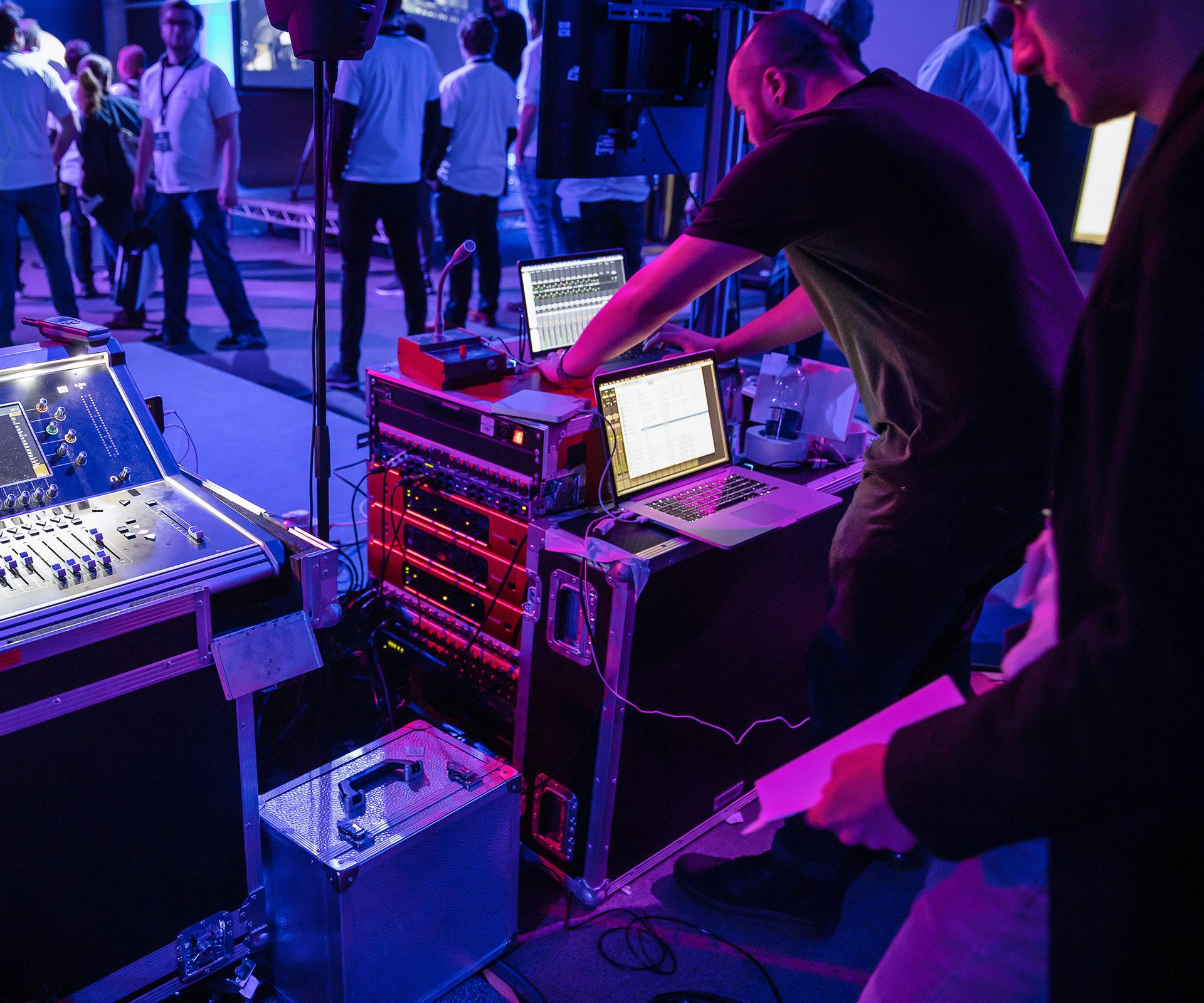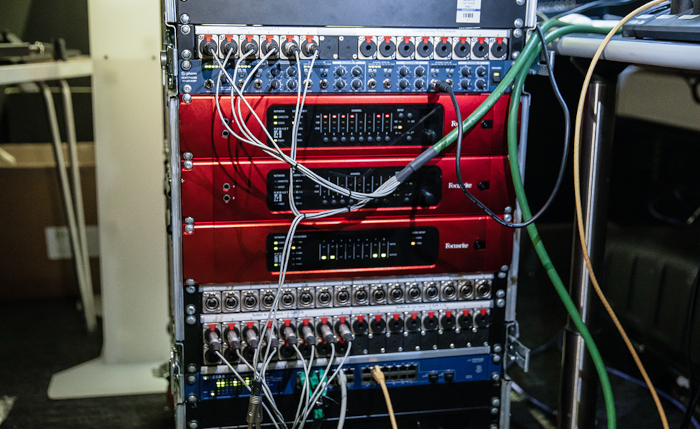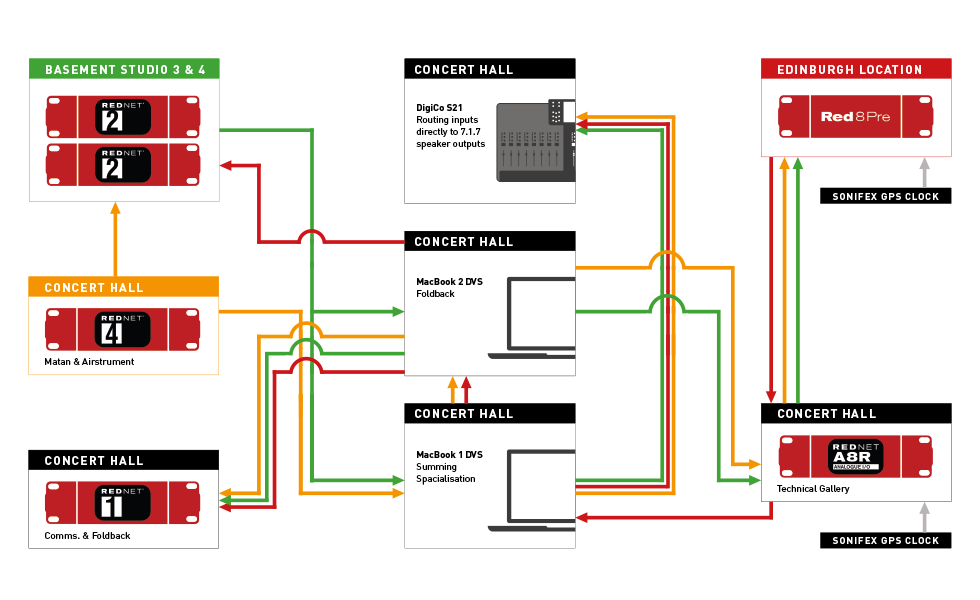RedNet Enables ‘World-First’ Cross-Border Interactive Performance
Innovation in Music is an annual conference, curated and hosted by the London College of Music at the University of West London (UWL). The multi-day event showcases cutting-edge research and thinking in the technology and techniques which can be applied to music creation and the wider context of audio production.
In recent years, a recurring theme has been networked audio. Twice in the recent past, Dr Paul Ferguson, Associate Professor of Audio Engineering at Edinburgh Napier University, has presented papers on creative collaboration in real time over a network. In 2013, his paper was concerned primarily with matters of audio quality, and in 2016 with creative collaboration over long distances. The two have traditionally been mutually exclusive. Studio quality or long distance: pick one. It was at the 2016 conference that Dr Ferguson made the prediction that the time would soon come when educational establishments and the wider audio community would be able to use Dante over long distances. At December's Innovation in Music 2019, conference-chair Professor Justin Paterson was inspired to devise and produce a keynote event, finally combining Ferguson's two imperatives; his earlier prediction coming to fruition, enabled by incremental advances in the state-of-the-art. The release of — and recent updates to — Audinate's Dante Domain Manager have conspired to allow for collaboration in real time, locked in sync over distance, at full quality.

This year's opening keynote performance was a world-first. Entitled Video Killed the Radio Star: How the Future Began, the combined talk and performance was a 45-minute immersive 7.1.7 audio piece from the Radio Science Orchestra led by songwriter Bruce Woolley (Cher, Grace Jones, The Orb, Nicky Minaj). The band featured instruments as diverse as harp, theremin, modular synth and ondes Martenot. Live VJ projections were created using bespoke patches by UWL's Carl Rohumaa, who directed a four-camera crew and three projectors (fed from live video splitters), using the audience as 'human pixels'. Woolley and his five-piece band were distributed across four separate performance spaces across the West London UWL campus, also accompanied in the auditorium by interdisciplinary artist and entrepreneur Matan Berkowitz who added synthetic layers, improvising using his self-designed gestural controller, the 'Airstrument'. From one of the remote performance spaces, the band also live-triggered video clips back in the auditorium using OSC messages. This was all connected by Dante using a total of three RedNet 4 interfaces.

Three RedNet 4 eight-channel Dante mic preamps were used to get in-house audio channels on the Dante network. Photo: Rich Nevens.
A further musician, Harry Docherty, was elsewhere. Specifically: at Edinburgh Napier University, some 400 miles away. He too was connected by Dante using a Focusrite Red 4Pre. Using a bespoke Max patch, he captured parts of the band's performance on the fly and processed them in real time, thus performing live with the Radio Science Orchestra, and woven into the band, their cue mixes, the immersive front-of-house mix and the video feeds back in London. Dante and front-of-house engineer for the performance, UWL's Scott Harker, observes, “admittedly, working in this way, with one of the musicians being 400 miles away, was odd at first rehearsal. Ultimately when it came to my mix, the routing and workflow, it was no different, just like any other room."
Behind the scenes, Dr Ferguson explains his journey to this point. “Previously, in the early days of RedNet, we were able to showcase high-quality, collaborative, networked audio. We've also been able to showcase the use of long-distance, low-latency networks. However, these networks either used compression, or weren't sufficiently robust in terms of the integrity of data packets to be useable in a real-time collaborative performance."

The system diagram for UWL's Innovation In Music event.
Both sites, being Universities, are connected to the JANET network (Joint Academic NETwork). JANET is a high-bandwidth network created specifically for use by the UK's research and education community. With around 18 million users, JANET is Europe's busiest national research and educational network based on volume of data carried. Combined with JANET's connectivity, the first release of Dante Domain Manager in 2017 offered a partial solution. Dante Domain Manager allows for logical groupings of Dante devices into Dante Domains, within which are user-defined Zone. A single Domain can contain member devices from different Zones (which in many scenarios will equate to different physical sites and subnets). While this functionality opened the door to Dante connections between sites, theoretically over any distance, the insurmountable issue of clock remained the key conundrum in Dr Ferguson's experimental work.
Without a robust, consistent and accurate clock, AoIP Networks simply don't perform in a way that can be guaranteed for professional purposes. Ferguson explains, “in a standard digital audio scenario, we wouldn't dream of sending audio between two devices without rock-solid and consistent clock. With Dante, that fundamental principle is no different. Certainly with Dante Domain Manager, we can now send a Dante stream containing clock packets from anywhere to anywhere. However, where the network between two devices spans hundreds of miles and isn't ours, that network is beyond our jurisdiction. We don't know the hardware hops or the traffic levels, so we'll always run the risk of not having that all-important, low jitter, consistent clock. It might be OK, or it might not. If it's not, the main symptom for the audio user at either end is generally silence!" September 2019 saw the updated release by Audinate of Dante Domain Manager v1.1. Among the list of new features, two are particularly significant: support for SMPTE 2110 / AES67 compliant devices in Dante workflows, and support for GPS Synchronisation.
The inclusion of AES67 and SMPTE 2110 support opened the door to a far broader set of tools to exist in a Dante environment. Unlike Dante, AES67 (ratified in 2013) is a low-level open interoperability standard, rather than a networking solution in its own right. A set of guidelines and technical standards concerned solely with the movement of digital audio. Support for AES67 audio streams has been part of Dante for some time. SMPTE 2110 meanwhile is an evolving and all-encompassing comprehensive media networking standard – catering for audio, video and ancillary data over IP. In turn, each element (e.g. audio, video) of a SMPTE 2110 workflow uses a standard of its own. In the case of audio, that's AES67; the common denominator. Thus, with no Dante-specific clocking option on the market, Ferguson looked to the newly-widened definition of 'SMPTE 2110 / AES67 compliant' to find a suitable technology solution.

Dr. Paul Ferguson (left) prepares the technical crew. Photo: Brian Greaves-Henriksen
The answer appeared in the form of a Sonifex product, the AVN-GMCS, an AES67 compliant grandmaster clock designed for use with AoIP applications. The AVN-GMCS uses PTPv2 (Precision Time Protocol v2) to synchronise devices on a network, having derived its own absolute time from the atomic clocks built into GPS satellites, much like any smartphone or in-car satellite navigation system. Indeed, global delivery of ultra-precise, unified time is one of the most important, and arguably most overlooked, functions of GPS satellites. All 31 GPS satellites currently orbiting the planet transmit the same, unified time (UTC), typically accurate to within 10 nanoseconds. A GPS receiver will scan and select the strongest signal of whichever satellites are currently visible at any given point on earth.
Ferguson expands on the GPS Sync workflow, “with Dante Domain Manager v1.1 we can now configure our setup such that our RedNet devices are assigned to geographic 'zones' that have a grandmaster clock in each zones. If we then use a GPS-based grandmaster clock in each zone — at each site — as the master clock for all devices in its immediate proximity, these independent clocks will be highly accurate, and they'll be the same frequency. In so doing, we bypass the issue of, and the problems attached to, sending clock over vast distances using Dante. Everything is rock-solid." The long-distance Dante network now established, latency became the next consideration for a group of musicians playing live through a variety of RedNet interfaces, receiving cue mixes and sending their performances via Dante to front-of-house.
Here, Ferguson draws a familiar parallel for many pro audio users, “much like when setting buffer size on a DAW, it's a trade-off between acceptable latency for the performing musicians versus system performance." Even with a firewall to contend with, early experiments revealed a 9.5ms round-trip time for data packets sent from London to Edinburgh and back. Whilst initially encouraging, the nature of the JANET network having 18 million users means that at peak times, the increased traffic would force this round-trip time to 15ms or more, with occasional peaks of up to 30ms. Ferguson reflects, “given this was a live, keynote performance to open the conference, I erred on the side of caution. Even though evenings are generally quiet times for traffic, we simply set the buffer on our RedNet interfaces to 20ms at each side: 40ms overall. A little longer than you'd ideally want for drums, but safe, and absolutely useable for the synthetic textures we were getting from Edinburgh."
It's perhaps most remarkable to note that every piece of technology employed was a current, off-the-shelf software or hardware product. Professor Paterson said, “like many good ideas, I came up with this one in the pub! Of course, it was only afterwards that I realised how complex it was going to be to pull such a multifaceted concert together, and it could only be done thanks to an amazing team, but it just could not have happened as it did without Paul and Focusrite — they made the Dante bit seem easy!"
Dr Ferguson's vision for the wider application of his setup goes beyond academia. The ability to collaborate and educate over Dante between institutions, between study programmes (or between widely distributed campuses) has clear equivalents in commercial studios, broadcast and post production. Ferguson concludes, “Inspired by our success at inMusic19, we have just successfully tested Focusrite/Dante and GPS between Edinburgh and Berlin. We know that, just by doing nothing, the networks and connectivity available to us are getting better and costing less. Even with today's connectivity options, we've shown here that the technology to collaborate creatively over long distances using Dante is supported and exists today."
